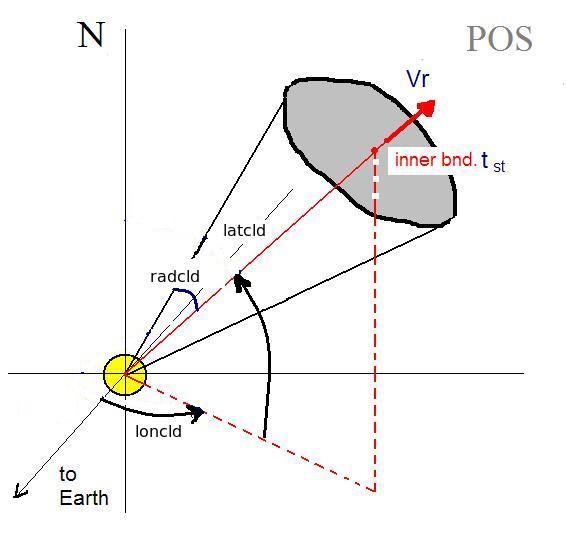Quoted from: https://ccmc.gsfc.nasa.gov/models/models_at_glance.php
Model Description
 ENLIL is a time-dependent 3D MHD model of the heliosphere. It solves equations for plasma mass, momentum and energy density, and magnetic field, using a Flux-Corrected-Transport (FCT) algorithm. Its inner radial boundary is located beyond the sonic point, typically at 21.5 or 30 solar radii. It can accept boundary condition information from either the WSA or MAS models. The outer radial boundary can be adjusted to include planets or spacecraft of interest (eg 2 AU to include both Earth and Mars, 5 AU to include Ulysses, 10 AU to include Cassini). It covers 60 degrees north to 60 degrees south in latitude and 360 degrees in azimuth.
ENLIL is a time-dependent 3D MHD model of the heliosphere. It solves equations for plasma mass, momentum and energy density, and magnetic field, using a Flux-Corrected-Transport (FCT) algorithm. Its inner radial boundary is located beyond the sonic point, typically at 21.5 or 30 solar radii. It can accept boundary condition information from either the WSA or MAS models. The outer radial boundary can be adjusted to include planets or spacecraft of interest (eg 2 AU to include both Earth and Mars, 5 AU to include Ulysses, 10 AU to include Cassini). It covers 60 degrees north to 60 degrees south in latitude and 360 degrees in azimuth.
ENLIL + Cone Model Description:
ENLIL cone model forecasts CME propagation from the ENLIL inner boundary (which is usually at 21.5 Rs) to the point of interest. The cone model is based on the idea that close to the Sun CME propagates with constant angular and radial velocity, and so has the shape of a cone. ENLIL takes the cone model input parameters at its inner boundary. These input parameters are the following (in Heliocentric Earth equatorial coordinates (HEEQ), where longitude=0 is in the Earthward direction).
1. Start date (yyyy-mm-dd).
2. Start time (hh-mm)
This is the moment of time (UT) when the CME reaches ENLIL inner boundary.
3. Cone latitude (deg).
Co-latitude of the cone axis (angle latcld in the Figure 1)
4. Cone longitude (deg).
Longitude of the CME cone axis (angle loncld in the Figure 1, (note Long=0 degrees is in the Earthward direction )
5. Cone radius (deg).
Half of the full angular width of the cone (angle radcld in the Figure 1).
6. Radial velocity (km/s) at the ENLIL inner boundary.
References and relevant publications
- Odstrcil, D.: 2003, Modeling 3-D solar wind structure. Advances in Space Research 32, 497 - 506. doi:10.1016/S0273-1177(03)00332-6.
- Odstrcil, D., Pizzo, V.J.: 1999a, Three-dimensional propagation of CMEs in a structured solar wind flow: 1. CME launched within the streamer belt. J. Geophys. Res. 104, 483 - 492. doi:10.1029/1998JA900019.
- Odstrcil, D., Pizzo, V.J.: 1999b, Three-dimensional propagation of coronal mass ejections in a structured solar wind flow 2. CME launched adjacent to the streamer belt. J. Geophys. Res. 104, 493 - 504. doi:10.1029/1998JA900038.
- Odstrcil, D., Riley, P., Zhao, X.P.: 2004, Numerical simulation of the 12 May 1997 interplanetary CME event. J. Geophys. Res. 109, 2116. doi:10.1029/2003JA010135.
- Odstrcil, D., Smith, Z., Dryer, M.: 1996, Distortion of the heliospheric plasma sheet by interplanetary shocks. Geophys. Res. Lett. 23, 2521 - 2524. doi:10.1029/96GL00159.
- Xie et al., JGR, vol 109, A03109; doi:10.1029/2003JA010226, 2004.
Relevant links
CCMC Contact(s)
Peter MacNeice
301-286-2061
Developer Contact(s)
D. Odstrcil



 ENLIL is a time-dependent 3D MHD model of the heliosphere. It solves equations for plasma mass, momentum and energy density, and magnetic field, using a Flux-Corrected-Transport (FCT) algorithm. Its inner radial boundary is located beyond the sonic point, typically at 21.5 or 30 solar radii. It can accept boundary condition information from either the WSA or MAS models. The outer radial boundary can be adjusted to include planets or spacecraft of interest (eg 2 AU to include both Earth and Mars, 5 AU to include Ulysses, 10 AU to include Cassini). It covers 60 degrees north to 60 degrees south in latitude and 360 degrees in azimuth.
ENLIL is a time-dependent 3D MHD model of the heliosphere. It solves equations for plasma mass, momentum and energy density, and magnetic field, using a Flux-Corrected-Transport (FCT) algorithm. Its inner radial boundary is located beyond the sonic point, typically at 21.5 or 30 solar radii. It can accept boundary condition information from either the WSA or MAS models. The outer radial boundary can be adjusted to include planets or spacecraft of interest (eg 2 AU to include both Earth and Mars, 5 AU to include Ulysses, 10 AU to include Cassini). It covers 60 degrees north to 60 degrees south in latitude and 360 degrees in azimuth.




